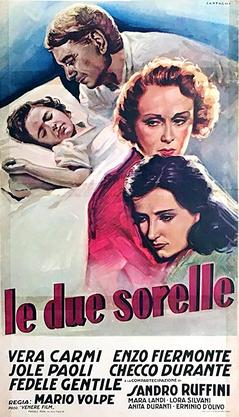| The Two Sisters | |
|---|---|
 | |
| Directed by | Mario Volpe |
| Written by | Enrica Bacci Aida Marchetti Hally Müldray Wanda Petti Mario Volpe |
| Starring | Vera Carmi Enzo Fiermonte Checco Durante |
| Cinematography | Mauro Chiodini |
| Edited by | Dolores Tamburini |
| Music by | Gino Filippini |
Production company | Venere Film |
| Distributed by | Independenti Regionali |
Release date |
|
Running time | 82 minutes |
| Country | Italy |
| Language | Italian |
| Box office | ₤110 million [1] |
The Two Sisters (Italian : Le due sorelle) is a 1950 Italian melodrama film directed by Mario Volpe and starring Vera Carmi, Enzo Fiermonte and Checco Durante. [2] The film's sets were designed by the art director Ivo Battelli. It was made at the Palatino Studios in Rome while location shooting took place around Matera in Basilicata. [3]